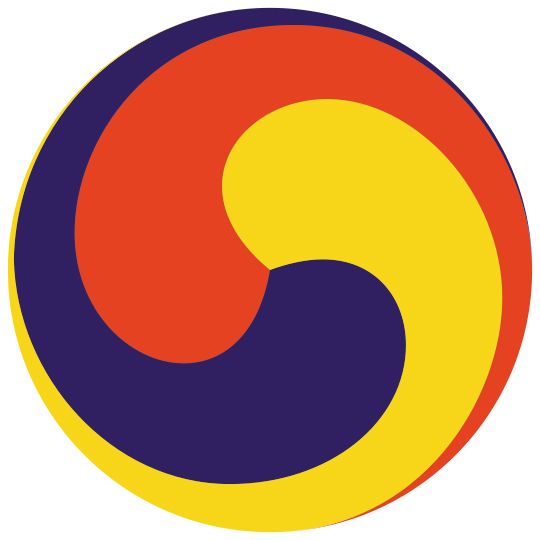|

Taeguekki
Det koreanske flag
I de fleste dojanger i Danmark hænger der to flag: Det danske Dannebrog og det koreanske Taegeukgi. En Taekwondo-lektion begynder altid med, at man hilser på flagene, da et af Taekwondo's principper er respekt.
I Danmark bør Taegeukgi stå som et symbol på den Taekwondo vi dyrker.
Ifølge koreanerne, så repræsentere Taeguekki alt tings oprindelse i universet.
I centrum sidder Yin og Yang (jing og jang). "Yin" er det negative aspekt, vist i blåt og "Yang" er det positive aspekt, vist i rødt. Blå repræsentere havet og Rød repræsentere himlen (den røde solnedgang som det kendes fra det japanske flag).
Til sammen udgør Yin og Yang en helhed. Yin og Yang har et uendeligt antal af symbolske betydninger Lys/Mørke, Nat/Dag, Opbygning/Nedbrydning, Aktiv/Passiv, Godt/Ondt. Den ene kan ikke eksistere uden den anden. De repræsentere samtidig en uendelig bevægelse hvor de to smelter sammen til en
Rundt om Yin og Yang sidder der fire "bjælke-symboler" som på koreansk hedder GWE. Disse har naturligvis en betydning - eller flere betydninger. De fire GWE'er er:
|
Navn |
Natur |
Sæson |
Retning |
Dyder |
Familie |
4 elementer |
Betydning |
 |
geon
(건 / 乾) |
Himmel
(천 / 天) |
Forår
(춘 / 春) |
Øst
(동 / 東) |
Menneskelighed
(인 / 仁) |
Fader
(부 / 父) |
Metal
(금 / 金) |
Retfærdighed
(정의 / 正義) |
 |
ri
(리 / 離) |
Sol
(일 / 日) |
Efterår
(추 / 秋) |
Syd
(남 / 南) |
courtesy
(예 / 禮) |
Søn
(중남 / 子) |
Ild
(화 / 火) |
Visdom
(지혜 / 智慧) |
 |
gam
(감 / 坎) |
Måne
(월 / 月) |
Vinter
(동 / 冬) |
Nord
(북 / 北) |
Intiligens
(지 / 智) |
Datter
(중녀 / 女) |
Vand
(수 / 水) |
Vitalitet
(생명력 / 生命力) |
 |
gon
(곤 / 坤) |
Jorden
(지 / 地) |
Sommer
(하 / 夏) |
Vest
(서 / 西) |
righteousness
(의 / 義) |
Moder
(모 / 母) |
Jord
(토 / 土) |
Fertilitet
(풍요 / 豊饒) |

RØD: PANTONE 186
BLÅ: PANTONE 294
Taegeuk is the Korean cognate of Taiji, the Taoist concept of yin and yang, from which all is actualized. In South Korea, the Taegeuk symbol is typically portrayed in blue (eum, or earth) and red (yang, or heaven). The red and blue are portrayed upside down to accommodate the harmony of nature. The blue (eum) on the flag is intended to pair up with the actual heaven (yang) and create a harmony with red, which would pair up with the actual earth (eum). An example would be have two magnets adjoining each other, "Taegeuk" symbol being in the middle. If the symbol is portrayed according to how humans view the world, red on the top would repel the earth and blue on the bottom would repel the heaven; this would break the harmony of nature.
The Taegeuk symbol is most prominently displayed on South Korea's national flag, called the Taegeukgi (along with four of the eight Palgwae diagrams). Because of the Taegeuk's association with the national flag, it is often used as a patriotic symbol, as are the colors red and blue.

A popular variant in Korea is the Sam-Taegeuk (三太極), which adds a yellow lobe, representing humanity, to the red and blue.
The Sam-Taegeuk is frequently seen as a design on the face of fans.
Taegeuk (as well as palgwe) is also a series of Taekwondo forms practiced by Kukkiwon member instructors and their students; see Taeguk (Taekwondo).


|